
Gouramis, or gouramies, are a group of freshwater anabantiform fish that comprise the family Osphronemidae. The fish are native to Asia—from the Indian Subcontinent to Southeast Asia and northeasterly towards Korea. The name "gourami", of Indonesian origin, is also used for fish of the families Helostomatidae and Anabantidae.

Cryptocoryne is a genus of aquatic plants from the family Araceae. The genus is naturally distributed in tropical regions of India, Southeast Asia and New Guinea. The English common name "water trumpet" refers to their inflorescence, a spadix enclosed by a spathe, which resembles a trumpet. The genus is commonly referred to as to as Crypts by aquarium hobbyists.
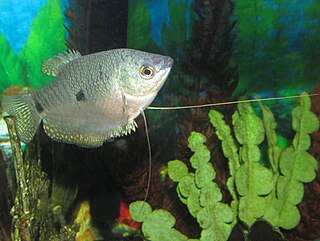
The three spot gourami, also known as the opaline gourami, blue gourami, and gold gourami, is a species of fish native to southeastern Asia, but also introduced elsewhere. This gourami gets its name from the two spots along each side of its body in line with the eye, considered the third spot. This species is of minor commercial importance as a food fish in its native range and is also farmed. It is also popular in the aquarium trade. The species reaches 15 cm in standard length.

The Kapuas River is a river in the Indonesian part of Borneo island, at the geographic center of Maritime Southeast Asia. At 1,143 kilometers (710 mi) in length, it is the longest river in the island of Borneo and the longest river in Indonesia and one of the world's longest island rivers. It originates in the Müller mountain range at the center of the island and flows west into the South China Sea creating an extended marshy delta. The delta is located west-southwest of Pontianak, the capital of the West Kalimantan province. This Kapuas River should be distinguished from another Kapuas River, which starts on the other side of the same mountain range in central Borneo but flows to the south, merging with the Barito River and discharging into the Java Sea.
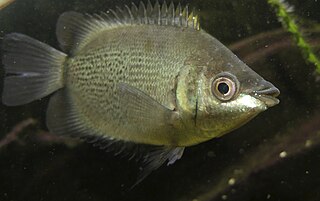
Kissing gouramis, also known as kissing fish or kissers, are medium-sized tropical freshwater fish comprising the monotypic labyrinth fish family Helostomatidae. These fish originate from Mainland Southeast Asia, the Greater Sundas and nearby smaller islands, but have also been introduced outside their native range. They are regarded as a food fish and they are sometimes farmed. They are used fresh for steaming, baking, broiling, and pan frying. The kissing gourami is a popular aquarium fish.

Léon Louis Vaillant was a French zoologist. He is most famous for his work in the areas of herpetology, malacology, and ichthyology.

The chocolate gourami is a species of gourami native to the Malay Peninsula, Sumatra, and Borneo. Chocolate gouramis reach a length of 6 cm (2.4 in). These fish have a chocolate colour with golden bands running down their bodies.
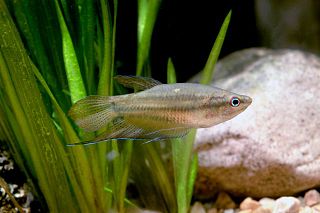
The croaking gourami is a species of small freshwater labyrinth fish of the gourami family. They are native to still waters in Southeast Asia and are distributed worldwide via the aquarium trade. Croaking gouramis are capable of producing a "croaking" noise using their pectoral fins.

The pygmy gourami, also known as the sparkling gourami, is a freshwater species of gourami native to Southeast Asia.

The Anabantoidei are a suborder of anabantiform ray-finned freshwater fish distinguished by their possession of a lung-like labyrinth organ, which enables them to breathe air. The fish in the Anabantoidei suborder are known as anabantoids or labyrinth fish, or colloquially as gouramies. Some labyrinth fish are important food fish, and many others, such as the Siamese fighting fish and paradise fish, are popular as aquarium fish.

Osphronemus is a genus of large gouramis, the only genus within the subfamily Osphroneminae. These fish are known as the giant gouramis and are native to rivers, lakes, pools, swamps and floodplains in Southeast Asia, with O. exodon from the Mekong basin, O. laticlavius and O. septemfasciatus from Borneo, while O. goramy is relatively widespread. O. goramy has been introduced outside its native range in Asia, Africa and Australia.

The peaceful betta or crescent betta is a species of gourami native to Southeast Asia.
Betta mandor is a species of gourami endemic to the island of Borneo where it is only known from the Indonesian province of Kalimantan Barat where it is found in the Kapuas basin. It is an inhabitant of streams and pools in forested swamps, usually found in quite shallow waters. It feeds on insects and other small invertebrate prey. This species can reach a length of 5.7 centimetres (2.2 in) TL. This species can also be found in the aquarium trade.

Rasbora sarawakensis, also known as the blue line rasbora or Sarawak rasbora, is a species of ray-finned fish in the genus Rasbora which is endemic to the island of Borneo.

Pangio semicincta, the half-banded kuhli loach, is a species of cobitid loach in the genus Pangio found in the Malay Peninsula, Borneo, and Sumatra. It is a very popular fish in the aquarium trade, however, it is often confused for and mislabeled as Pangio kuhlii, a slightly larger-bodied fish, which is rarely found in the aquarium trade due to it being endemic to Java, Indonesia, where field-collection for the fish trade is a rare occurrence.

Vaillantella maassi, the forktail loach, is a species of loach in the family Vaillantellidae, a monogeneric family with two other species, Vaillantella cinnamomea and Vaillantella euepiptera. They are from Southeast Asia.

Sphaerichthys is a genus of gouramis native to Southeast Asia known as chocolate gourami. These species live mostly in blackwater rivers/swamps with acidic water. They have dark-light brownish hues with the exception being the female of S. vaillanti which can be dark reddish brown with green-dark blue/black stripes. They are shy fish that are hard to find because of their camouflage which when in action makes them look like a dead leaf floating along the river.
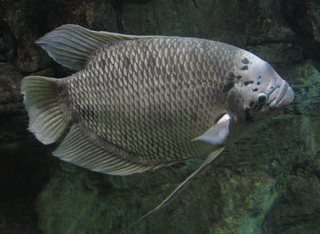
The giant gourami is a species of large gourami native to freshwater habitats in Southeast Asia. It has also been introduced elsewhere. The species is commercially important as a food fish and is also farmed. It can be found in the aquarium trade, as well. The species has been used for weed control on highly invasive aquatic plants like Salvinia molesta, as the giant gourami can be a voracious herbivore.
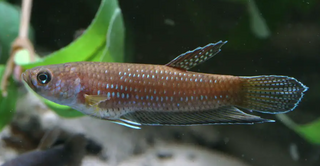
Betta antoni is a species of gourami endemic to the Sanggau area in the Kapuas region. The species name antoni is named after Irwan Anton "in recognition of his generous help and gift of specimens". This species grows to a length of 8 centimetres (3.1 in) SL. According to Linke, they live in "densely vegetated, narrow watercourses with very soft, very acidic water".

Betta pi is a species of gourami belonging to the genus Betta. It is found in the Pru Toe-Daeng peat swamps in Narathiwat Province in Southern Thailand, but its range also extends into northern Peninsular Malaysia, most notably the states of Kelantan and Terengganu. It is primarily found in well-shaded peat forest blackwater swamps and creeks where the pH can be as low as 3.0 or 4.0. It is benthopelagic. It can grow to a maximum length of 9.0 cm (3.5 in). It is a fish of mild importance in the aquarium industry. Its diet consists of aquatic invertebrates in the wild, but will also eat frozen, live and dried foods such as larva of Chironomidae, Daphnia, and brine shrimp in aquariums.




























